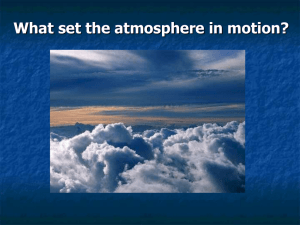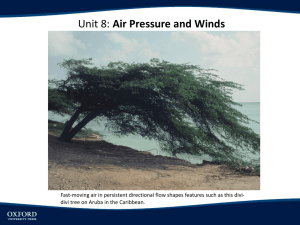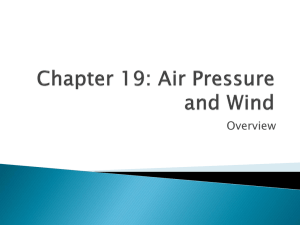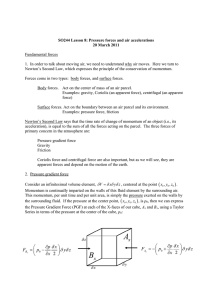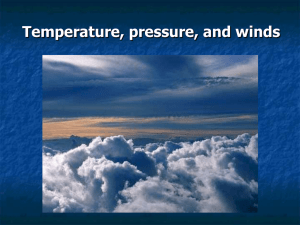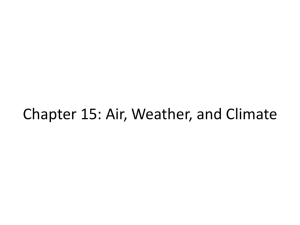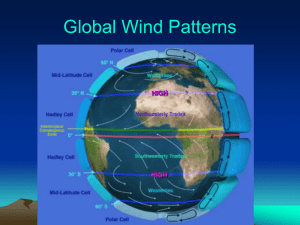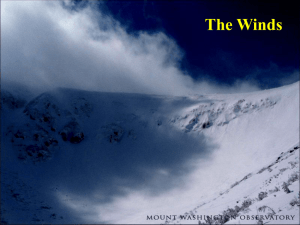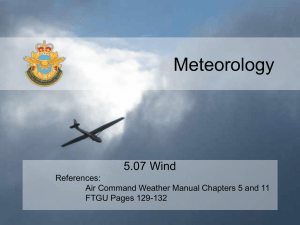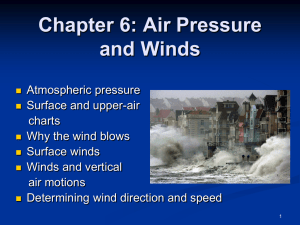Force Balances
advertisement
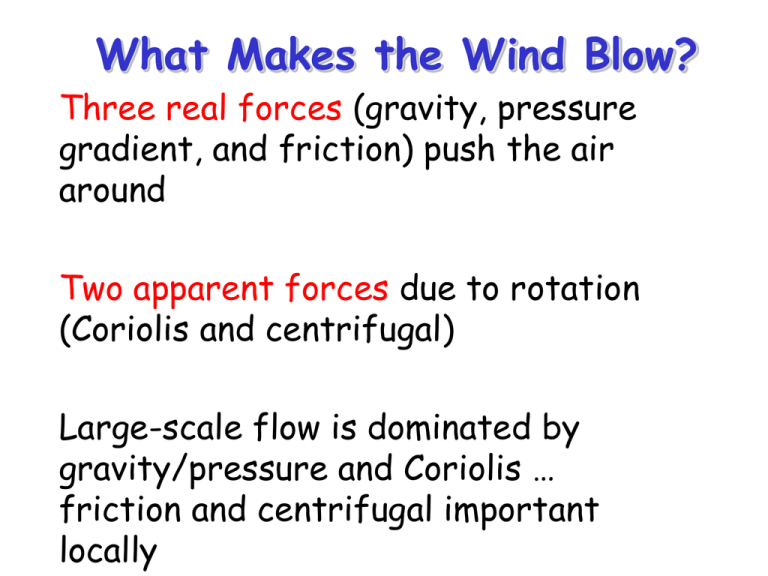
What Makes the Wind Blow? Three real forces (gravity, pressure gradient, and friction) push the air around Two apparent forces due to rotation (Coriolis and centrifugal) Large-scale flow is dominated by gravity/pressure and Coriolis … friction and centrifugal important locally Newton å F = ma • Objects stay put or move uniformly in the same direction unless acted on by a force • Acceleration is a result of the sum (net) of forces, in the vector sense Forces Acting on the Air • Pressure gradient force (pushing) • Gravity (falling) • Friction (rubbing against the surface) • “Apparent” forces – The Coriolis Force – Centrifugal Force Pressure Gradient Force • Magnitude – Inversely proportional to the distance between isobars or contour lines • The closer together, the stronger the force • Direction – Always directed toward lower pressure Coriolis Force • Magnitude – Depends upon the latitude and the speed of movement of the air parcel • The higher the latitude, the larger the Coriolis force – zero at the equator, maximum at the poles • The faster the speed, the larger the Coriolis force • Direction – The Coriolis force always acts at right angles to the direction of movement • To the right in the Northern Hemisphere • To the left in the Southern Hemisphere Coriolis Force • Acts to right in northern hemisphere • Proportional to wind speed Centrifugal Force • When viewed from a fixed reference frame, a ball swung on a string accelerates towards to center of rotation (centripetal acceleration) • When viewed from a rotating reference frame, this inward acceleration (caused by the string pulling on the ball) is opposed by an apparent force (centrifugal force). Centrifugal Force • Magnitude – depends upon the radius of curvature of the curved path taken by the air parcel – depends upon the speed of the air parcel • Direction – at right angles to the direction of movement Geostrophic Balance • The “Geostrophic wind” is flow in a straight line in which the pressure gradient force balances the Coriolis force. Lower Pressure 994 mb 996 mb 998 mb Higher Pressure Note: Geostrophic flow is often a good approximation high in the atmosphere (>500 meters) Pressure patterns and winds aloft At upper levels, winds blow parallel to the pressure/height contours Gradient Wind Balance • The “Gradient Wind” is flow around a curved path where there are three forces involved in the balance: – 1. – 2. – 3. Pressure Gradient Force Coriolis Force Centrifugal Force • Important in regions of strong curvature (near high or low pressure centers) Gradient Wind Balance • Near a trough, wind slows as centrifugal force adds to Coriolis • Near a ridge, wind speeds up as centrifugal force opposes Coriolis Friction is Important Near Earth’s Surface • Frictional drag of the ground slows wind down – Magnitude • Depends upon the speed of the air parcel • Depends upon the roughness of the terrain • Depends on the strength of turbulent coupling to surface – Direction • Always acts in the direction exactly opposite to the movement of the air parcel • Important in the turbulent friction layer (a.k.a. the “planetary boundary layer”) • ~lowest 1-2 km of the atmosphere • Flow is nearly laminar aloft, friction negligible! Three-Way Balance Near Surface (Pressure + Coriolis + Friction) • Friction can only slow wind speed, not change wind direction • Near the surface, the wind speed is decreased by friction, so the Coriolis force is weaker & does not quite balance the pressure gradient force – Force imbalance (PGF > CF) pulls wind in toward low pressure – Angle at which wind crosses isobars depends on turbulence and surface roughness • Average ~ 30 degrees Geostrophic Wind Plus Friction Lower Pressure 994 mb 996 mb 998 mb Higher Pressure Wind doesn’t blow parallel to the isobars, but is deflected toward lower pressure; this happens close to the ground where terrain and vegetation provide friction Surface Pressure Patterns and Winds Near the surface in the Northern Hemisphere, winds blow – counterclockwise around and in toward the center of low pressure areas – clockwise around and outward from the center of high pressure areas Converging Wind, Vertical Motion, and Weather! • Surface winds blow – In toward center of low pressure (convergence) – Out from center of high pressure (divergence) • Air moves vertically to compensate for surface convergence or divergence – Surface convergence leads to divergence aloft – Surface divergence leads to convergence aloft Global and Synoptic Scale Circulation Systems Poleward energy transport on a rotating sphere Hadley cells and Ferrel cells Polar vortex and midlatitude jet streams Midlatitude cyclones as waves The circulations of the atmosphere and oceans are ultimately driven by solar and longwave radiation imbalances If the Earth didn’t rotate, it would be easy for the flow of air to balance the energy • Thermal convection leads to formation of convection cell in each hemisphere • Energy transported from equator toward poles • Surface wind in Colorado would always blow from the North Wind Patterns on the Rotating Earth • Deep thermally direct convective cells confined to tropics • Condensation heating in rising branch of Hadley Cell lifts the center of mass of the atmosphere (converts latent to potential energy) • Downhill slope toward winter pole produces jet streams in middle latitudes • Jet is unstable to small perturbations, breaks down in waves wavy westerlies ITCZ easterly Trade Winds Key Features of Global Circulation • Hadley cell (thermally direct cell) - driven by N-S gradient in heating - air rises near equator and descends near 30 degrees - explains deserts; trade winds; ITCZ • Ferrel Cell (indirect thermal cell) - driven by heat transports of eddies - air rises near 60 degrees and descends near 30 degrees - explains surface westerlies from 30-60 • Weak winds found near – Equator (doldrums) – 30 degrees (horse latitudes) • Boundary between cold polar air and mid-latitude warmer air is the polar front Today’s Circulation Surface Winds and Pressure January July Understanding the Atmospheric Circulation 1. Driven by differential solar heating between the equator and poles. Atmospheric general circulation acts to move heat poleward. 2. In Hadley cell, warmer air rises and moves poleward. Equator-to-pole Hadley cell is impossible in the presence of rotation 3. In the Northern Hemisphere, air is deflected to the right as it moves; in the Southern Hemisphere, it is deflected toward the left. - rotation produces trade winds; surface westerlies in NH; upper tropospheric jets. 4. Ferrel cell is the “zonal mean” response to poleward heat and momentum fluxes by eddies. It runs backwards! Transports heat the wrong way!
